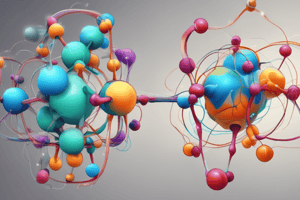Podcast
Questions and Answers
The mutual sharing of electrons takes place to form compound?
The mutual sharing of electrons takes place to form compound?
- Sodium
- Neon
- Sulphur (correct)
- Phosphorous
Which one is noble or inert nature?
Which one is noble or inert nature?
- Boron
- Aluminium
- Neon (correct)
- Calcium
Which of the following compounds possesses a covalent bond?
Which of the following compounds possesses a covalent bond?
- BaCl2
- H2O (correct)
- CaCl2
- AlCl3
The arrangement of 8 electrons in the outermost shell of the atom is called?
The arrangement of 8 electrons in the outermost shell of the atom is called?
Which one is an example of a coordinate bond?
Which one is an example of a coordinate bond?
Why do atoms share electrons in covalent bonds?
Why do atoms share electrons in covalent bonds?
Calcium chloride is formed by the linkage?
Calcium chloride is formed by the linkage?
The noble gases such as helium and neon are?
The noble gases such as helium and neon are?
Gain of electrons takes place to complete the last shell by?
Gain of electrons takes place to complete the last shell by?
Bond formed by sharing of six electrons is called?
Bond formed by sharing of six electrons is called?
In the formation of $Mg^{2+}$ ion, which one is the correct reaction in the following?
In the formation of $Mg^{2+}$ ion, which one is the correct reaction in the following?
Observe the following characteristics is suitable for covalent compound?
Observe the following characteristics is suitable for covalent compound?
How many valence electrons are present in an oxygen atom?
How many valence electrons are present in an oxygen atom?
Name the metallic nature of an atom?
Name the metallic nature of an atom?
Which of the following diatomic molecules is joined by a double covalent bond?
Which of the following diatomic molecules is joined by a double covalent bond?
Which of the following covalent bonds is the most polar?
Which of the following covalent bonds is the most polar?
What causes hydrogen bonding?
What causes hydrogen bonding?
Which of the following elements can form diatomic molecules held together by triple covalent bonds?
Which of the following elements can form diatomic molecules held together by triple covalent bonds?
Once formed, how are coordinate covalent bonds different from other covalent bonds?
Once formed, how are coordinate covalent bonds different from other covalent bonds?
What is the name of the ionic compound formed from sodium and bromine?
What is the name of the ionic compound formed from sodium and bromine?
Which one of the following describes the major intermolecular force in I2(s)?
Which one of the following describes the major intermolecular force in I2(s)?
Flashcards are hidden until you start studying
Study Notes
Chemical Bonding Basics
- Compounds are formed through the mutual sharing of electrons.
- Sulfur is an element that exemplifies this sharing mechanism.
- Noble gases like neon exhibit inert qualities, meaning they do not readily react with other elements.
- Water (H2O) is a classic example of a compound with covalent bonds.
Electron Configuration
- The octet rule describes the arrangement of 8 electrons in the outermost shell of an atom, contributing to its stability.
- Atoms share electrons to achieve a noble-gas electron configuration, enhancing stability.
Types of Bonds
- Ionic bonds are formed through the complete transfer of electrons.
- Electrovalent (ionic) bonds are seen in compounds like calcium chloride (CaCl2), formed by the linkage of metal and non-metal ions.
- Covalent bonds result from the sharing of electron pairs between atoms.
- Co-ordinate bonds involve one atom donating both electrons to the bond, seen in molecules like carbon dioxide (CO2).
- A single covalent bond is formed by the sharing of one pair of electrons, while double covalent bonds—seen in oxygen (O2)—involve two shared pairs.
Key Characteristics of Covalent Compounds
- Covalent compounds typically have low melting and boiling points compared to ionic compounds.
- Oxygen has 6 valence electrons, playing a critical role in its bonding characteristics.
- Properties of covalent bonds include strength and polarization, with some being more polar than others, such as hydrogen fluoride (H-F).
Ionic Compounds
- Sodium bromide is the name for the ionic compound formed from sodium (Na) and bromine (Br).
- Metals generally lose electrons to form positive ions (cations), while non-metals gain electrons to form negative ions (anions).
Bonding Theories and Effects
- Hydrogen bonding results from the attraction between a covalent hydrogen atom and an unshared electron pair.
- Coordinate covalent bonds differ from normal covalent bonds in that they typically exhibit greater strength.
- The properties of a bond dictate how atoms interact and form compounds across various chemical reactions.
Summary of Significant Equations and Reactions
- The reaction for forming the Mg²⁺ ion can be described as: Mg → Mg²⁺ + 2e⁻.
- The major intermolecular forces in solid iodine (I2) are dipole-dipole forces, distinct from covalent or ionic bonding.
Periodic Trends
- Elements are categorized based on their properties; for instance, the periodic table includes non-metals that tend to gain electrons (anions).
- Metals possess a tendency to lose electrons, aiding in the formation of ionic bonds.
Understanding Bond Characteristics
- The most polar covalent bond is the one between hydrogen and fluorine (H-F).
- Compounds with a triple bond (like nitrogen in N2) show a stronger attraction due to the sharing of three pairs of electrons.
Studying That Suits You
Use AI to generate personalized quizzes and flashcards to suit your learning preferences.




